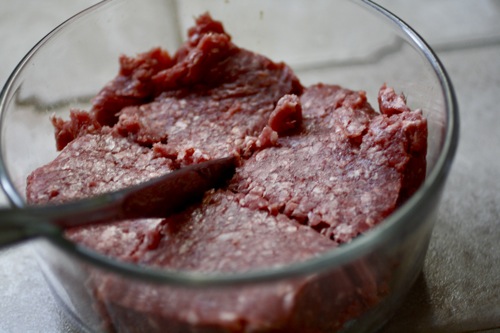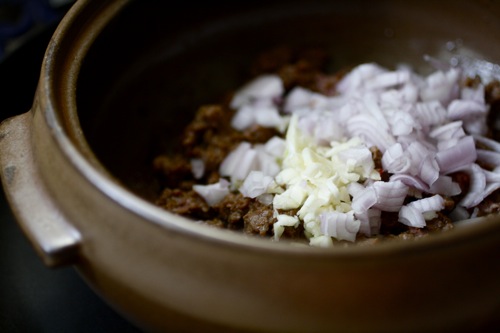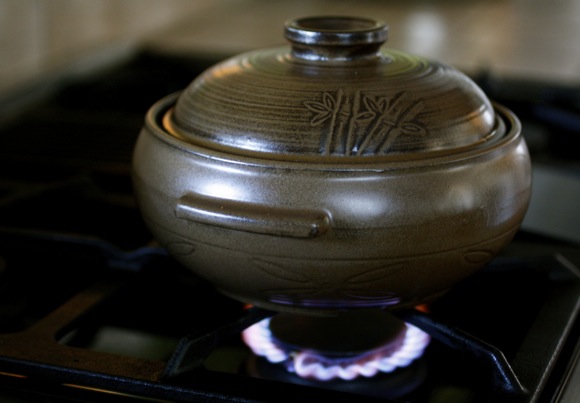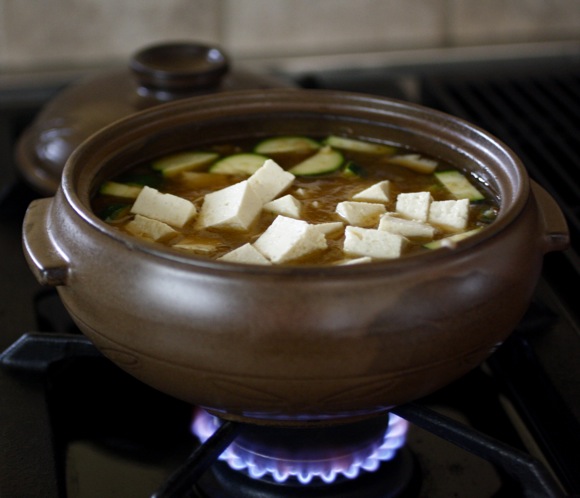A Korean Fermented Soybean Paste Stew with Bison
and
Zucchini, Shiitake, Tofu, Red Chile, Green Onion, Garlic, Sesame Oil
I make this intensely-flavored savory Korean soybean paste stew with bison. Bison might be a bit more flavorful and a little sweeter, and is naturally leaner than beef. It has more protein and iron too. Federal regulations prohibit the use of hormones in bison. The herd is raised without antibiotics as well.
Doenjang is Korean fermented soybean paste. It has rich umami flavors, and can be described as earthy, nutty, smoky, roasted, intense, tangy. Just two tablespoons of doenjang gives this stew a full-bodied pungent taste.
Heat a casserole dish or tukbaege (traditional Korean earthenware pot) over high heat,
add 1 T. sesame oil. Mix in 2 T. doenjang.
Add 4 oz. fresh ground bison. Stir with a wooden spoon to mix the meat, doenjang, and sesame oil.
Once the meat has just barely browned, add a couple cloves of chopped garlic and a chopped shallot.
Mix and sauté for about 3 minutes.
Add 2 c. fish stock. (Dashi or even bottled clam juice are fine substitutes).
Bring stock to a boil.
The tukbaege serves a dual purpose. It is the cooking vessel and a handsome serving vessel as well.
The clay pot retains heat, so the stew remains hot at the table.
Add 5 or 6 quartered shittake. Simmer for 10 minutes.
Add a sliced zucchini and a half block of cubed firm tofu, bring to a boil again.
Add sliced red chiles and simmer for 5 more minutes.
These fresno peppers which are medium-hot with thin skins, are perfect in this chigae (stew).
Garnish with sliced green onion and a drizzle of sesame oil.
Doenjang Chigae 된장 찌개
To make doenjang fresh soybeans are boiled, steamed then crushed and formed into bricks called meju. They are left to ferment with rice straw and the right amount of sunlight and warmth, for one to three months. After fermentation the meju is stacked in enormous jars, covered with saltwater and left to ferment again for up to two months. The salt water becomes soy sauce and the meju is crushed, jarred and left to fermented again for a few more months.
The beauty of doenjang chigae is that an extraordinary stew of incredible depth and complexity can be prepared in less than 25 minutes. This is because the doenjang has been months in the making, resulting in an enigmatic paste with exotic and haunting flavors.













Lori Lynn – you are giving me a culinary education. Korean food is so new to me. It would never occur to my addled brain to use bison in Asian cooking and there you are creating a dish that warms me from the photos. I love depth in stew and shall check out the wonders of doenjang chigae.
This looks amazing. Where can I get a tukbaege. Can I get it at the oriental market?
I’ve never had bison but with all the plus points mentioned, I’d give it a try. Love the spiciness and intense flavour of Korean soups. This certainly looks so tempting.
Sounds delicious! We just did a show using bison meat, it is really good…even the kids like it, the picky things! Must try this for an adult dinner. Beautiful pics, as always.
This looks so tasty and delicious! I love foods cooked in claypot as they retain the heat so well and keeps it warm, especially in the winter. The tukbaege does make a handsome serving vessel 🙂
Doenjang chigae is one of my favorite Korean soups! 🙂
I admire you for trying Korean recipes. Korean food is sooo delicious! And props on using bison!